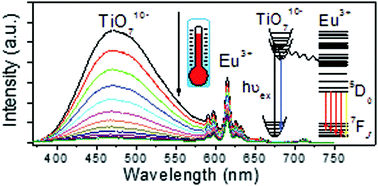当前位置:
X-MOL 学术
›
J. Mater. Chem. C
›
论文详情
Our official English website, www.x-mol.net, welcomes your
feedback! (Note: you will need to create a separate account there.)
On the luminescence of Ti4+ and Eu3+ in monoclinic ZrO2: high performance optical thermometry derived from energy transfer
Journal of Materials Chemistry C ( IF 5.7 ) Pub Date : 2020/02/07 , DOI: 10.1039/c9tc06992e Guo-Hui Pan 1, 2, 3, 4, 5 , Liangliang Zhang 1, 2, 3, 4, 5 , Huajun Wu 1, 2, 3, 4, 5 , Xuesong Qu 6, 7, 8, 9 , Hao Wu 1, 2, 3, 4, 5 , Zhendong Hao 1, 2, 3, 4, 5 , Ligong Zhang 1, 2, 3, 4, 5 , Xia Zhang 1, 2, 3, 4, 5 , Jiahua Zhang 1, 2, 3, 4, 5
Journal of Materials Chemistry C ( IF 5.7 ) Pub Date : 2020/02/07 , DOI: 10.1039/c9tc06992e Guo-Hui Pan 1, 2, 3, 4, 5 , Liangliang Zhang 1, 2, 3, 4, 5 , Huajun Wu 1, 2, 3, 4, 5 , Xuesong Qu 6, 7, 8, 9 , Hao Wu 1, 2, 3, 4, 5 , Zhendong Hao 1, 2, 3, 4, 5 , Ligong Zhang 1, 2, 3, 4, 5 , Xia Zhang 1, 2, 3, 4, 5 , Jiahua Zhang 1, 2, 3, 4, 5
Affiliation

|
Monoclinic ZrO2 (m-ZrO2) is an attractive material for photonic applications due to its low site symmetry and phonon energy. In this paper, we present detailed studies on the luminescence properties of Ti4+ and Eu3+ in m-ZrO2. In view of the continuing controversy over the origin of “intrinsic” white-blue luminescence in pristine m-ZrO2, more spectroscopic information obtained by characterizing m-ZrO2 intentionally doped with Ti4+, Ti3+ and other metal ions and extensive discussions on the general characteristics of different luminescence processes were provided to evidence the luminescence as the Ti3+ → O− charge transfer transition in the [Ti(IV)O7]10− complex due to the trace amount of Ti4+ impurity in ZrO2 reagent. Competitive absorption was observed between host exciton and oxygen–metal charge transfer processes (O2−–Ti4+, O2−–Eu3+), and even between the two types of charge transfer process because of the sharing of electrons at the top of the valence band, which greatly influenced the absorption and excitation processes. The spectral components comprising the broad excitation band of O2−–Ti4+ white-blue or Eu3+ red emissions in different phosphors were identified, and their evolutions with doping concentration were explained. The energy state locations of oxygen defects produced by intrinsic charge compensation in m-ZrO2:Eu3+ were proposed to be ∼2.41 eV above the top of the valence band by using Eu3+ for the luminescent probe. Efficient energy transfer from the [Ti(IV)O7]10− complex to Eu3+ was first observed in m-ZrO2:Ti4+,Eu3+ phosphors, which were demonstrated to be high performance ratiometric self-referencing optical thermometric materials based on the dual-emitting combination strategy, with the relative sensitivity amounting to ∼3.84% K−1. Optical thermometry not only covering the physiological temperature range but also with high relative sensitivity could be achieved upon appropriate doping.
中文翻译:

关于单斜ZrO2中Ti4 +和Eu3 +的发光:能量转移产生的高性能光学测温法
单斜晶ZrO 2(m-ZrO 2)由于其低的位置对称性和声子能量而成为一种有吸引力的光子应用材料。在本文中,我们对Ti 4+和Eu 3+在m-ZrO 2中的发光性质进行了详细的研究。鉴于原始m-ZrO 2中“本征”白蓝色发光的起源仍存在争议,通过表征故意掺有Ti 4 +,Ti 3+和其他金属离子的m-ZrO 2的特性获得了更多的光谱信息,讨论了不同发光过程的一般特性,以证明发光为Ti3+ →O; -在所述电荷转移过渡钛[Ti( IV)O 7 ] 10-复因的Ti的微量4+杂质以ZrO 2试剂。主机激子和氧-金属电荷转移过程之间观察到竞争性吸收率(O 2- -Ti 4+,O- 2- -Eu 3+),甚至这两种类型的电荷转移过程中的由于在共享电子之间在价带的顶部,极大地影响了吸收和激发过程。光谱成分包括O 2-- Ti 4+的宽激发带确定了不同磷光体中的白蓝色或Eu 3+红色发射,并解释了它们随掺杂浓度的变化。通过使用Eu 3+作为发光探针,提出了在m-ZrO 2:Eu 3+中由固有电荷补偿产生的氧缺陷的能态位置在价带顶部上方约2.41 eV 。从[Ti(IV)O 7 ] 10-络合物到Eu 3+的有效能量转移首先在m-ZrO 2:Ti 4+,Eu 3+中观察到荧光粉,被证明是一种基于双发射组合策略的高性能比例自参考光学测温材料,相对灵敏度约为3.84%K -1。通过适当的掺杂,可以实现不仅覆盖生理温度范围而且具有高相对灵敏度的光学测温法。
更新日期:2020-04-03
中文翻译:

关于单斜ZrO2中Ti4 +和Eu3 +的发光:能量转移产生的高性能光学测温法
单斜晶ZrO 2(m-ZrO 2)由于其低的位置对称性和声子能量而成为一种有吸引力的光子应用材料。在本文中,我们对Ti 4+和Eu 3+在m-ZrO 2中的发光性质进行了详细的研究。鉴于原始m-ZrO 2中“本征”白蓝色发光的起源仍存在争议,通过表征故意掺有Ti 4 +,Ti 3+和其他金属离子的m-ZrO 2的特性获得了更多的光谱信息,讨论了不同发光过程的一般特性,以证明发光为Ti3+ →O; -在所述电荷转移过渡钛[Ti( IV)O 7 ] 10-复因的Ti的微量4+杂质以ZrO 2试剂。主机激子和氧-金属电荷转移过程之间观察到竞争性吸收率(O 2- -Ti 4+,O- 2- -Eu 3+),甚至这两种类型的电荷转移过程中的由于在共享电子之间在价带的顶部,极大地影响了吸收和激发过程。光谱成分包括O 2-- Ti 4+的宽激发带确定了不同磷光体中的白蓝色或Eu 3+红色发射,并解释了它们随掺杂浓度的变化。通过使用Eu 3+作为发光探针,提出了在m-ZrO 2:Eu 3+中由固有电荷补偿产生的氧缺陷的能态位置在价带顶部上方约2.41 eV 。从[Ti(IV)O 7 ] 10-络合物到Eu 3+的有效能量转移首先在m-ZrO 2:Ti 4+,Eu 3+中观察到荧光粉,被证明是一种基于双发射组合策略的高性能比例自参考光学测温材料,相对灵敏度约为3.84%K -1。通过适当的掺杂,可以实现不仅覆盖生理温度范围而且具有高相对灵敏度的光学测温法。











































 京公网安备 11010802027423号
京公网安备 11010802027423号